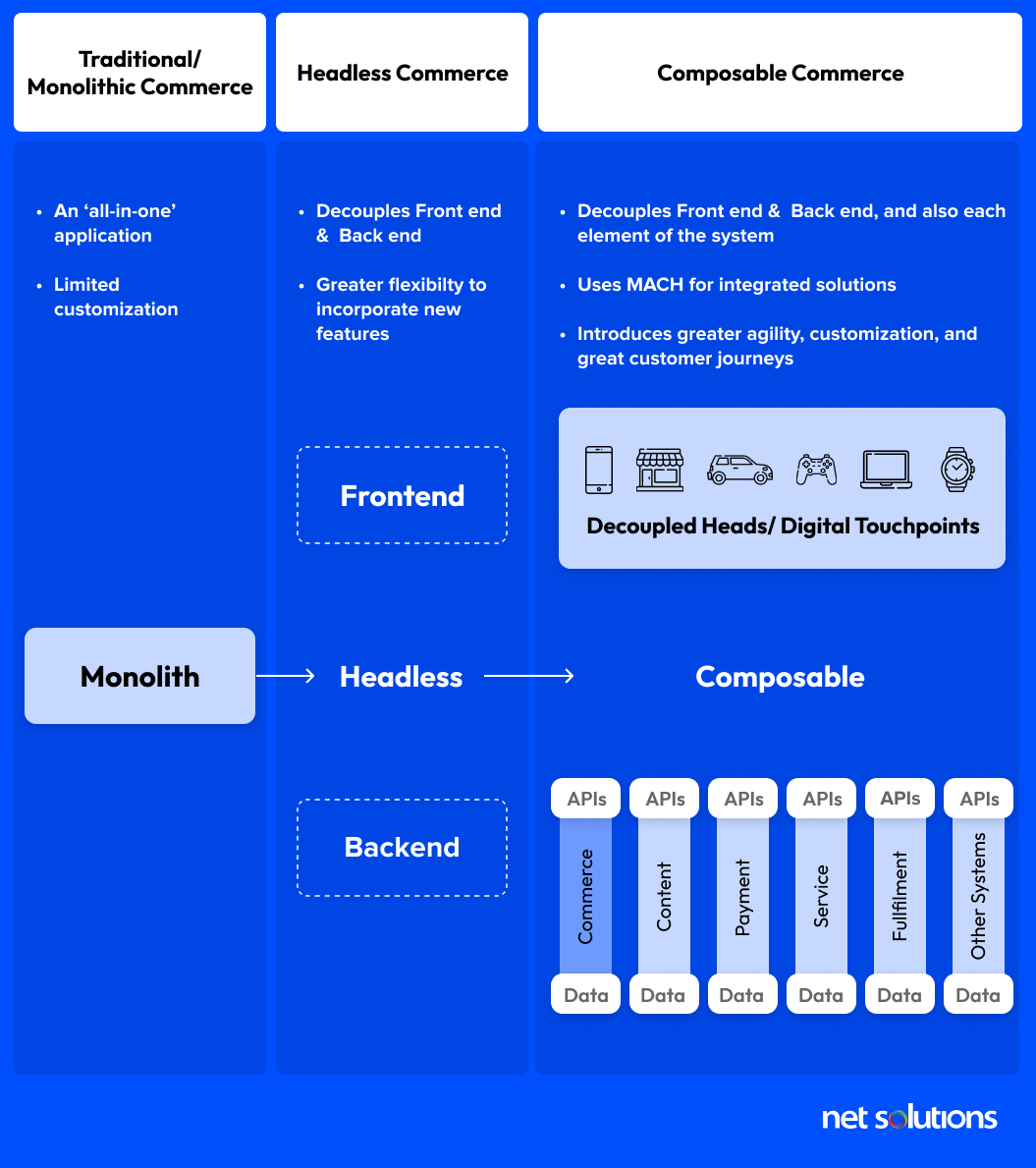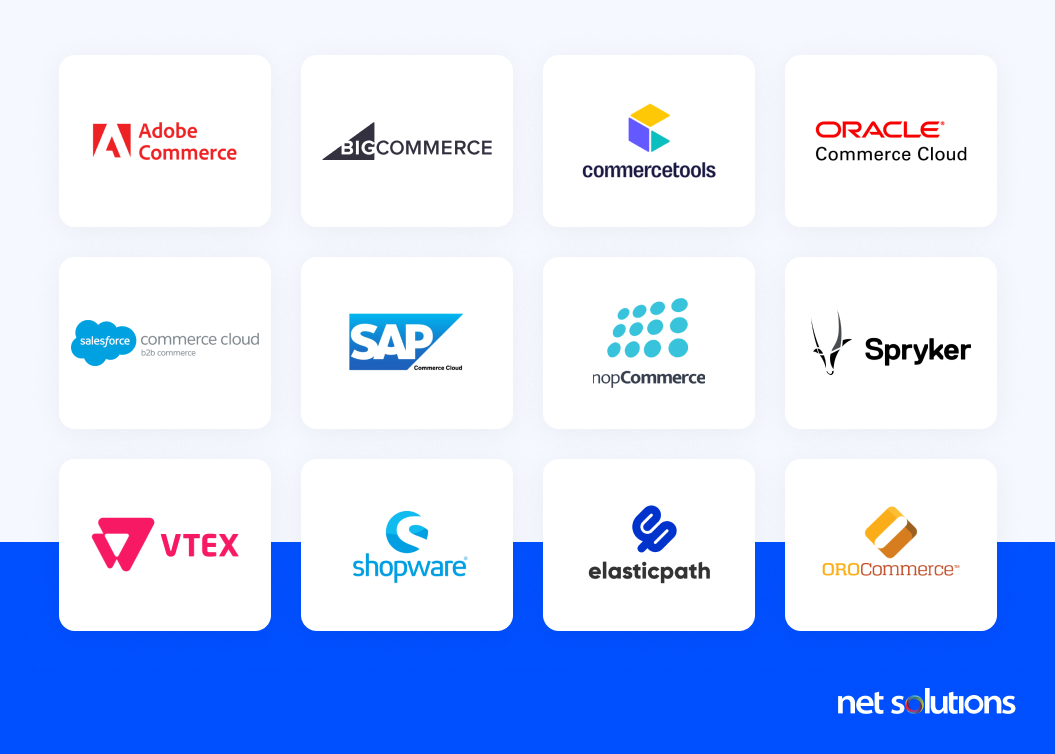As business buyers shift their preferences to digital buying and modern digital experiences, B2B sales are at a “tipping point,” notes Gartner. At this tipping point, the gap between those companies that exceed revenue targets and those that miss their targets is becoming increasingly larger.
Those companies that make the strategic shift to a “buyer-centric operating model” have the resources and eCommerce tools to rapidly adjust to buyer expectations, supporting digital sales with innovations in personalization, conversational analytics, and intelligent search. Those companies rely on outdated sales processes and tools—those held back by legacy eCommerce platforms—will fall further behind.

* Gartner, Sales Strategy: Fuel Enterprise Success Today and Tomorrow; Avionos, No More Excuses: The Time for B2b Digital Transformation is Now; Deloitte Digital, Four B2B commerce trends that separate front runners from the pack; Adobe, The 2024 B2B Commerce Trends & Data Report
The decision to replatform (move from one eCommerce platform to another) is not a technical decision, it’s a strategic business decision driven by persistent performance issues, technology limitations, or obstacles to growth. The reality is, if your buyers are vetting you based upon the digital experience you deliver, your choice of eCommerce platform can be the difference between growth and stagnation.
While the impetus is there to drive your B2B eCommerce digital transformation, replatforming is a significant undertaking—one that requires careful planning, execution, and ongoing management.
In this guide, we will share insights into how our clients have incorporated eCommerce replatforming into their strategic future roadmaps, the guidance we provide on platform choice, the steps we take to ensure success, and common challenges you may encounter in a replatforming project.
Key Takeaways:
- Leading B2B businesses have technology that adapts to changing buyer expectations and helps reach new audiences
- Modern B2B eCommerce platforms support both buyers and sellers
- Careful planning can stop a replatforming project from derailing
- Even the largest companies may lack the skills, time or resources to dedicate to replatforming
What is B2B eCommerce Replatforming?
“Replatforming is a strategic initiative to transform commerce experiences through an evolution in technology.”
Replatforming is the process of shifting infrastructure from one platform to another to achieve better performance, scalability, and flexibility, to reduce cost, or to unlock other business benefits. However, this definition often understates how transformative the shift can be. Instead, it can be helpful to think of replatforming as a strategic initiative to support commerce experiences through an evolution in technology that may include: modern composable and headless commerce platforms, user experience (UX) design, and integration with the latest technological innovations.
A decision to embark on a strategic transformation of commerce infrastructure is the result of ongoing and persistent issues that are increasing costs and/or impeding growth.

B2B eCommerce has seen significant growth in the past decade, anticipated to be valued at $36 trillion by 2026. This growth has fueled innovation in B2B eCommerce platforms, with new and existing players refining B2B-specific features and integrating the latest innovations in personalization, multi-store and catalog management, self-service buyer enablement capabilities and automations that serve both buyer and seller experiences. For B2B companies who were early adopters of eCommerce, it’s very likely your current legacy platform lacks these core B2B eCommerce features. Without these capabilities for your B2B website, you likely struggle to attract, convert and retain online buyers or grow your business to new markets, regions or channels.
Aside from wanting to harness new features and capabilities, most companies considering replatforming have experienced a whole host of issues associated with legacy systems that have been adapted and customized over the course of many years. Companies simply reach the end of the line where the cost and time associated with a legacy system has become too high—operational cost, lack of features, customization constraints, end of life (EOL) components, and a lack of agility.
Euro Car Parts Boosts Revenue by 2300% (in 5 years) After Replatforming
As a partner in architecting and managing Euro Car Parts’ commerce infrastructure, Net Solutions has played a pivotal role in the continued evolution of the commerce capabilities of the UK’s leading distributor of car parts.
Since 2009, Net Solutions has helped bring to life a series of digital properties and apps for Euro Car Parts. Over time, this included expanding platform capabilities, adding integrations, and expanding to support marketplace sales. However, there came a point in time when adding capabilities to a legacy system (custom PHP) was no longer in the best interest of the company. The idea to replatform came up during a regular strategic roadmapping activity between Euro Car Parts and Net Solutions.
Net Solutions CTO Joseph Jude worked closely with Euro Car Parts to identify several functional and non-functional limitations associated with their existing infrastructure—technical debt, security challenges, performance issues, associated SEO challenges, disorganized catalog growth, and a desire to improve the customer experience.
Net Solutions played a pivotal role in Euro Car Parts’ subsequent transformation, which included a shift from a more traditional implementation to an API-driven design (still custom) and redesigning the user experience. In the years following the transformation, and with continued improvements made possible thanks to a more agile platform, Euro Car Parts now manages over half a million products and 12k-15k orders per day. With these transformative efforts, Euro Car Parts has seen success across all key performance indicators (KPIs):
| <2 second page load, even at peak | 5.8-10% conversion on web | 67% increase in app conversion | Mobile traffic increased from 20-65% | £1 Billion in sales |
It’s likely a mix of reasons that brought you here—frustration, lost revenue, inefficiencies, and/or limitations in delivering on the buyer experience. Let’s explore if replatforming is the right choice for you.
Is Replatforming Right for You?
At this stage, you recognize the challenges you’re having with your existing commerce infrastructure, but an experienced partner can help you evaluate if your current implementation can be improved or if it’s time to replatform. If you’ve been trying to “make it work” with your existing platform and now want to know if replatforming is right for you, consider the following:
1. Future-proof infrastructure
Most legacy commerce software is monolithic: one huge codebase that supports the backend functionality as well as a single user interface. Since you’re probably already selling on more than one channel, and maybe even with an app, chances are you have a lot of duplication in your infrastructure.
Moving toward a headless or composable B2B eCommerce platform is one of the hottest B2B eCommerce trends, a move that can help future-proof your commerce infrastructure, making it faster and easier to integrate new technology and expand to new channels. Many headless and composable platforms also come with tools to support hybrid sales (e.g. AI-supported quoting), personalize content and promotions, and support customer service.

2. Easier scaling
Future-proofing your infrastructure also means planning for your future scaling needs, both horizontally and vertically. Legacy software is often not built to handle increased load or traffic, often requiring workarounds to manage system limitations. Cloud-based commerce platforms are a secure and cost-effective solution to tap into enterprise-ready scalability and performance.
| Cloud SaaS or PaaS | On-Premise licensed or open-source |
|---|---|
| Hosted eCommerce software on a scalable cloud platform that leverages a global CDN to optimize performance, as well as automatic updates and managed services (e.g. backup, security) | Free or licensed eCommerce software you host yourself, assuming all responsibility for maintenance, security and optimization |
Many organizations also find limitations with horizontal scaling when legacy systems lack multi-store capabilities or support for both B2B and B2C sales, often requiring parallel implementations (increasing operational costs) and data silos that inhibit data-driven insights.
3. Less time spent on day-to-day tasks
Modern B2B eCommerce platforms are designed to streamline back-end operations through better system design, more self-service tools for buyers, and workflow automations. For example, some platforms are building in AI capabilities or can be connected with external tools that support predictive analytics and demand forecasting, inventory management, fulfillment, supply chain optimization, customer service (chatbots, content generation for help pages), marketing (SEO, content generation), and sales (transcripts, field pre-population, auto-invoice).
4. Increased security
If your legacy software has reached EOL, it is no longer being supported with new patches or updates, creating security vulnerabilities and potentially compliance challenges. One of the advantages of cloud-based eCommerce software is the built-in security features and capabilities, many of which meet international standards and can be adjusted to meet specific compliance requirements for your organization (e.g. local data storage).
5. Lower cost
Legacy and on-premise systems can be costly once you factor in the size of your IT team, technology costs (servers, depreciation), and the increasing costs to make changes to your system. There are also many hidden costs associated with legacy platforms—unexplained downtime, performance issues, longer sales response times. The longer you wait to replatform, the greater these costs (and lost revenue) will be.
6. Growth opportunities
On the flip side of cost is potential—the potential to move faster, stand out, try new things, capture more customers, keep more customers, expand customer lifetime value, and expand your business without expanding your infrastructure investment.
What about the Challenges of B2B eCommerce Replatforming?
No digital transformation is without risk. If poorly planned or managed, replatforming can result in:
- Data loss or corruption
- Possible downtime
- Unexpected integration challenges
- Lack of documentation about the current technical environment, leading to delays
- Compatibility issues with existing systems
- SEO impact
- Scope creep
- Negative impact on customer experience (downtime, broken features)
- Misalignment of project with expectations
The good news is that planning and experience can help mitigate or alleviate each of these challenges.
Planning and Strategy: How to Get Started with B2B eCommerce Replatforming
Once you’ve identified that replatforming is the appropriate strategy, it’s critical to take the time to plan out your project scope. Planning is the most critical stage in your transformation: the point in time where you either set yourself up for success or run the risk of your project growing in scope and complexity or failing to deliver on expectations.
1. Define the business use case and goals
This is the most critical step, where you examine where you are and where you want to be. This is made up of:
- A full platform assessment including a code audit, database audit, review of all 3rd party integrations, technical debt evaluation, performance testing, security testing, SEO benchmarking
- Document current deficiencies and pain points such as performance issues, deprecated functions, inadequately organized catalog, technical challenges
- Conduct a user experience audit to identify areas for improvement (design, features, integrations)
- Identify the KPIs you’re looking to drive
- Conduct a risk assessment
2. Choose the new eCommerce platform
We’ve compiled a list of our preferred B2B eCommerce platforms—those platforms designed specifically for B2B or which support both B2C, B2B, B2B marketplace, and B2B+ business models. Furthermore, we also lean toward platforms with multi-store capabilities that future-proof your growth potential.

Beyond looking for a commerce platform that can support B2B sales, there are a lot of factors to consider when choosing the right platform for you. With our clients, we tend to explore the following:
- Functional and non-functional requirements for the new platform
- Security considerations
- Pricing / licensing model
- Problem – solution fit
- Product review and ratings
- Partner ecosystem
- The existence and robustness of the development and support community
- Analyst standings (Gartner, IDC, Forrester)
- Documentation and training resources
The choice we make with one client may not be right for another.
Hancocks synchronizes channels with shift to Adobe Commerce
Hancocks is the UK’s largest confectionery wholesaler, serving more than 25,000 independent retailers with 14 cash and carry stores and an online channel that supports a quarter of its business. As Hancocks scaled its business, it began to outgrow the capabilities of Magento, a self-hosted open source eCommerce platform — they struggled to keep inventory levels in sync across channels and to manage the complexities of volume sales with B2B buyers.
Through word of mouth, Hancocks came to Net Solutions to create a strategic plan to transform its web presence. After considering viable alternatives such as BigCommerce and Contentful, Hancocks decided to replatform to Adobe Commerce on Cloud, which offered advanced B2B capabilities and wide partner ecosystem. Although Adobe offers detailed Magento to Adobe Commerce migration plans, Hancocks recognized the need for expert guidance on transformation to help resolve issues with inventory and to better support the buyer experience.
Net Solutions assisted Hancocks in the replatforming effort, re-launching its B2B website with a new design, new features, and a rebuilt mobile app (including the addition of Firebase offline capabilities). With the advanced inventory management capabilities of Adobe Commerce, set up and customized with the help of Net Solutions, Hancocks was able to completely resolve its inventory issues and reduce stockouts. Further, Net Solutions worked with marketing and sales to set up automations that would support promotions and new product launches.
As a result of the transformation, Net Solutions helped Hancocks streamline its sales operations and support the customer experience across physical and online channels, the result of which includes a 96% increase in app conversions.
3. Gather business requirements
At this stage, it is critical to establish a plan for the migration that is more comprehensive than just moving data from point A to point B. At Net Solutions, we work with clients to develop a 3-year plan of transformation and optimization.
- Create a comprehensive requirement document (backlog) to guide development and design priorities for the short term
- Create a 3-year plan that supports the extended backlog and unforeseen needs
- Set clear expectations for each stage of the plan (migration + future scope)
It is critical to plan for regular (quarterly and annually) strategic reviews, as well as platform and experience assessments, in order to identify deficiencies and identify opportunities for improvements. Experienced partners play a critical role in advising clients on trends, new technologies, and best practices.
4. Design platform architecture
Your eCommerce platform is just one piece of your commerce infrastructure. Planning for success requires designing the full technology stack:
- Integrations to your wider commerce ecosystem (CRM, CMS, ERP, PIM, inventory management)
- Third-party extensions (e.g. personalization, payment gateways, live search, product view enhancements, performance and monitoring tools)
- Custom features, extensions, or integrations (as needed)
- Self-hosted requirements (if applicable) including cloud infrastructure, CDN, firewall, and any software dependencies required for your installation
5. Establish budget and timeline
Once you have established your backlog and proposed a tech stack, you can create estimates that establish if you have adequate resources (skills, bandwidth, and budget) to support your project. Establish a timeline, including a target launch date and key milestones along the way.
If you haven’t already, now is a good time to bring on an experienced partner. Most clients we work with are able to identify earlier in the process that they lack both the experience and the bandwidth to replatform, giving us the opportunity to lend our expertise to the entire replatforming process.
6. Project execution
At this stage, design and technical teams are ready to take over execution of your preliminary replatforming transformation. In brief, your team will do the following:
- Create a detailed plan for data migration (backup, data mapping)
- Execute on design priorities (redesign, new workflows, new features)
- Run compatibility testing
- Begin an incremental data migration process
- Configuring all integrations and third-party services
- Test for and optimize the customer experience*
- Audit for SEO*, security and performance
- Comprehensive quality assurance testing
- Change management and training
- Launch (technical, marketing support)
- Post-launch support (marketing, user surveys, bug fixes)
- Continued transformation efforts following the 3-year plan
As the above list demonstrates, replatforming is not just a technical project, it is a transformation that incorporates people and processes into the effort. It is critical to support the transformation with change management efforts for both employees and buyers. For employees, change management efforts can build up excitement for the workflow improvements and to reduce friction when starting on a new system. For buyers, marketing can create change management campaigns to help set you up for success.
While the goal of any replatforming project is to ensure minimal disruption to business operations during the transition, it is critical to take the time for testing and to have a contingency plan in place in case of unexpected issues.
Fluctuations are normal
It is not uncommon to see architectural, URL, and UX changes lead to a short-term reversal of indexing or conversions. These are likely to resolve once search engines re-crawl your site and users take the time to get used to your new website.
Transformation doesn’t stop for Euro Car Parts
At Net Solution, we view replatforming as a process of technological evolution that begins with a new platform, but continues with continuous efforts to support scalability, functionality, and user experience.
To continue the example with our client Euro Car Parts, new platform architecture and continuous integration / continuous deployment (CI/CD) practices were just the beginning. Over the course of the next several years, as Euro Car Parts evolved its business, that work included integrating a new garage management solution, marketing and behavioral intelligence tools, new payment solutions (e.g. Google Play and Apple Pay) to enhance the customer experience, and creating new market opportunities such as Car Parts 4 Less.
How Can a B2B eCommerce Migration Partner Help?
If you are considering replatforming, this guide has likely demonstrated how many decisions go into planning for and executing on a transformation of this scope. While replatforming is undoubtedly a huge technical challenge, it’s equally important to get the strategy right before you start. A key ingredient in success is having teams with the experience and bandwidth to plan, research, launch, market, and optimize your replatforming effort.
Many organizations reach out to agencies with established eCommerce portfolios to gain invaluable knowledge about platforms, technologies, migrations and change management. Experienced migration partners can help create a replatforming plan that is tailored to your needs to help you maximize your ROI and reduce the chance of downtime.
At Net Solutions, we help visionary B2B companies future-proof their businesses by updating their tech stacks with innovative technology, improved processes, and continuous optimization.
Position Net Solutions is a trusted expert and partner in B2B eCommerce replatforming, helping companies such as Euro Car Parts, Hancocks, 2XU, and American Golf reach beyond industry benchmarks.
FAQ About Replatforming
1. What’s The Difference Between Replatforming And Refactoring?
Replatforming and refactoring two approaches to moving infrastructure. From a technical perspective, replatforming is meant to retain most of the existing structure and features of a site while refactoring involves reworking the code to remove technical debt related to old libraries, frameworks, or unnecessary features. However, in practical application, replatforming has become a generic term that encompasses any technology shift, regardless of the level of change made to the code and tools.
2. How long does replatforming take?
Replatforming projects can range from several weeks to several months, depending on the size of the catalog, the complexity and customization of existing infrastructure, the number of internal and external integrations, and the scope of change to code, libraries, frameworks, features, or design. The average project, with the help of an experienced partner, is 6-9 months.
SHARE THIS POST
Table of Contents
Related Resources
- AI in B2B eCommerce: Everything You Need to Know
- Top 14 B2B eCommerce Benefits in 2024
- The B2B eCommerce Catalog: Everything You Need to Know
- The Biggest B2B eCommerce Challenges (And How to Address Them)
- The Ultimate Guide to B2B Fashion eCommerce: Strategies, Trends, and Solutions
- 18 Must-Have B2B eCommerce Features To Look For in 2024
- Headless B2B eCommerce - How to Redefine Your Business
- B2B eCommerce Marketplaces: Your In-Depth Guide
- Top B2B eCommerce Metrics to Track for Success [2024]
- B2B Mobile eCommerce - A Comprehensive Guide
- Why Your Business Needs a B2B eCommerce Mobile App
- 11 Top B2B eCommerce Open Source Platforms for 2024 [With Real Reviews]
- B2B eCommerce Platform Costs: A Comprehensive Guide (2024)
- 12 Top B2B eCommerce Platforms for 2024 [With Real Reviews]
- B2B eCommerce Pricing Strategies: An In-Depth Guide
- Top 9 B2B eCommerce Trends to Watch in 2024
- B2B eCommerce UX: A Comprehensive Guide
- A Step-by-step Guide to B2B eCommerce Website Development
- 9 of the Best B2B eCommerce Website Examples in 2024

